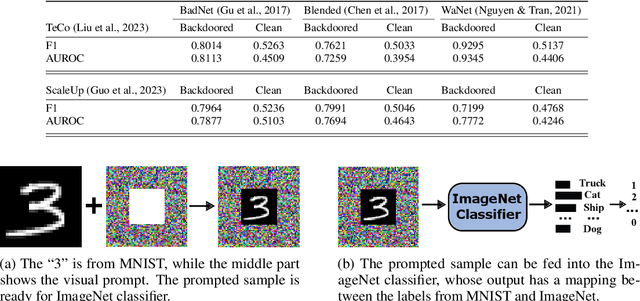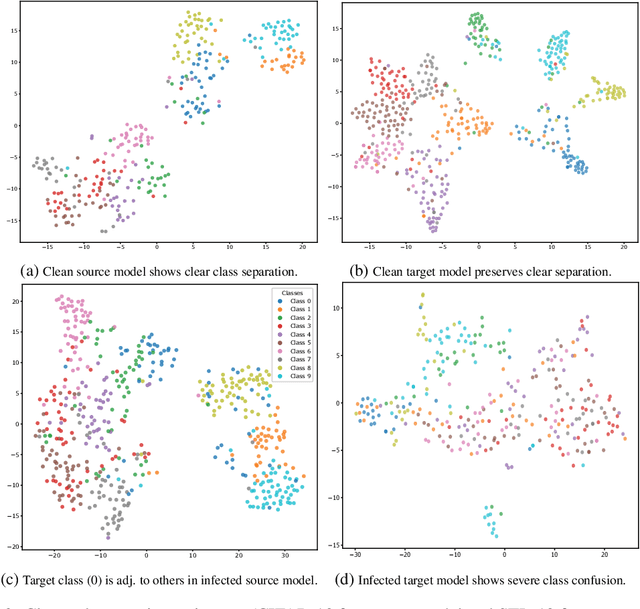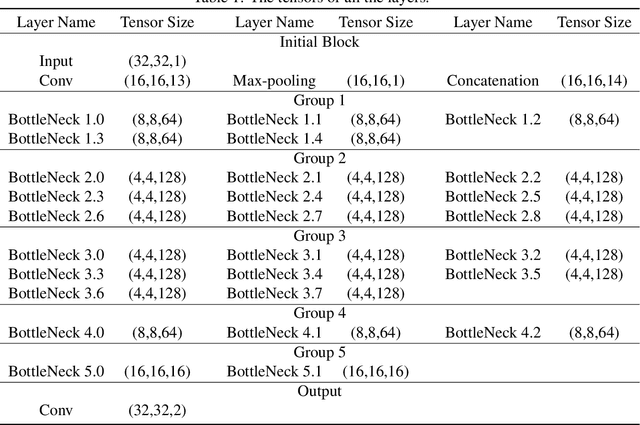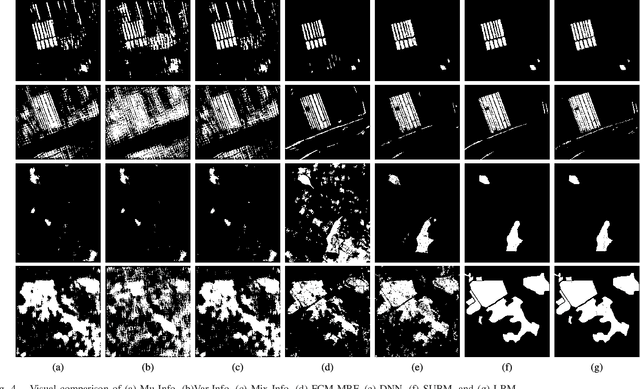Jia-Wei Chen
Prompting the Unseen: Detecting Hidden Backdoors in Black-Box Models
Nov 14, 2024



Abstract:Visual prompting (VP) is a new technique that adapts well-trained frozen models for source domain tasks to target domain tasks. This study examines VP's benefits for black-box model-level backdoor detection. The visual prompt in VP maps class subspaces between source and target domains. We identify a misalignment, termed class subspace inconsistency, between clean and poisoned datasets. Based on this, we introduce \textsc{BProm}, a black-box model-level detection method to identify backdoors in suspicious models, if any. \textsc{BProm} leverages the low classification accuracy of prompted models when backdoors are present. Extensive experiments confirm \textsc{BProm}'s effectiveness.
Perceptual Indistinguishability-Net (PI-Net): Facial Image Obfuscation with Manipulable Semantics
Apr 07, 2021



Abstract:With the growing use of camera devices, the industry has many image datasets that provide more opportunities for collaboration between the machine learning community and industry. However, the sensitive information in the datasets discourages data owners from releasing these datasets. Despite recent research devoted to removing sensitive information from images, they provide neither meaningful privacy-utility trade-off nor provable privacy guarantees. In this study, with the consideration of the perceptual similarity, we propose perceptual indistinguishability (PI) as a formal privacy notion particularly for images. We also propose PI-Net, a privacy-preserving mechanism that achieves image obfuscation with PI guarantee. Our study shows that PI-Net achieves significantly better privacy utility trade-off through public image data.
A Light-Weighted Convolutional Neural Network for Bitemporal SAR Image Change Detection
Jun 21, 2020



Abstract:Recently, many Convolution Neural Networks (CNN) have been successfully employed in bitemporal SAR image change detection. However, most of the existing networks are too heavy and occupy a large volume of memory for storage and calculation. Motivated by this, in this paper, we propose a lightweight neural network to reduce the computational and spatial complexity and facilitate the change detection on an edge device. In the proposed network, we replace normal convolutional layers with bottleneck layers that keep the same number of channels between input and output. Next, we employ dilated convolutional kernels with a few non-zero entries that reduce the running time in convolutional operators. Comparing with the conventional convolutional neural network, our light-weighted neural network will be more efficient with fewer parameters. We verify our light-weighted neural network on four sets of bitemporal SAR images. The experimental results show that the proposed network can obtain better performance than the conventional CNN and has better model generalization, especially on the challenging datasets with complex scenes.
A Convolutional Neural Network with Parallel Multi-Scale Spatial Pooling to Detect Temporal Changes in SAR Images
May 22, 2020



Abstract:In synthetic aperture radar (SAR) image change detection, it is quite challenging to exploit the changing information from the noisy difference image subject to the speckle. In this paper, we propose a multi-scale spatial pooling (MSSP) network to exploit the changed information from the noisy difference image. Being different from the traditional convolutional network with only mono-scale pooling kernels, in the proposed method, multi-scale pooling kernels are equipped in a convolutional network to exploit the spatial context information on changed regions from the difference image. Furthermore, to verify the generalization of the proposed method, we apply our proposed method to the cross-dataset bitemporal SAR image change detection, where the MSSP network (MSSP-Net) is trained on a dataset and then applied to an unknown testing dataset. We compare the proposed method with other state-of-arts and the comparisons are performed on four challenging datasets of bitemporal SAR images. Experimental results demonstrate that our proposed method obtains comparable results with S-PCA-Net on YR-A and YR-B dataset and outperforms other state-of-art methods, especially on the Sendai-A and Sendai-B datasets with more complex scenes. More important, MSSP-Net is more efficient than S-PCA-Net and convolutional neural networks (CNN) with less executing time in both training and testing phases.
SAR Image Change Detection via Spatial Metric Learning with an Improved Mahalanobis Distance
Jun 19, 2019



Abstract:The log-ratio (LR) operator has been widely employed to generate the difference image for synthetic aperture radar (SAR) image change detection. However, the difference image generated by this pixel-wise operator can be subject to SAR images speckle and unavoidable registration errors between bitemporal SAR images. In this letter, we proposed a spatial metric learning method to obtain a difference image more robust to the speckle by learning a metric from a set of constraint pairs. In the proposed method, spatial context is considered in constructing constraint pairs, each of which consists of patches in the same location of bitemporal SAR images. Then, a semi-definite positive metric matrix $\bf M$ can be obtained by the optimization with the max-margin criterion. Finally, we verify our proposed method on four challenging datasets of bitemporal SAR images. Experimental results demonstrate that the difference map obtained by our proposed method outperforms than other state-of-art methods.
Imbalanced Learning-based Automatic SAR Images Change Detection by Morphologically Supervised PCA-Net
Jun 19, 2019



Abstract:Change detection is a quite challenging task due to the imbalance between unchanged and changed class. In addition, the traditional difference map generated by log-ratio is subject to the speckle, which will reduce the accuracy. In this letter, an imbalanced learning-based change detection is proposed based on PCA network (PCA-Net), where a supervised PCA-Net is designed to obtain the robust features directly from given multitemporal SAR images instead of a difference map. Furthermore, to tackle with the imbalance between changed and unchanged classes, we propose a morphologically supervised learning method, where the knowledge in the pixels near the boundary between two classes are exploited to guide network training. Finally, our proposed PCA-Net can be trained by the datasets with available reference maps and applied to a new dataset, which is quite practical in change detection projects. Our proposed method is verified on five sets of multiple temporal SAR images. It is demonstrated from the experiment results that with the knowledge in training samples from the boundary, the learned features benefit for change detection and make the proposed method outperforms than supervised methods trained by randomly drawing samples.
 Add to Chrome
Add to Chrome Add to Firefox
Add to Firefox Add to Edge
Add to Edge